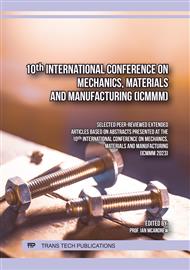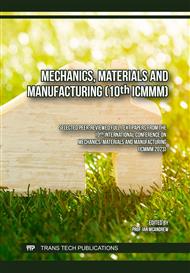[1]
J. S. Randhawa and I. S. Ahuja, "Empirical investigation of contributions of 5S practice for realizing improved competitive dimensions," Int. J. Qual. Reliab. Manag., vol. 35, no. 3, p.779–810, 2018, doi: 10.1108/IJQRM-09- 2016-0163/FULL/PDF.
DOI: 10.1108/ijqrm-09-2016-0163
Google Scholar
[2]
E. Pop, G.-I. Ilcea, and I.-A. Popa, "Distance Control and Positive Security for Intrinsic Equipment Working in Explosive Potential Atmospheres," Engineering, vol. 10, no. 03, p.75–84, 2018.
DOI: 10.4236/eng.2018.103006
Google Scholar
[3]
P. Aqueveque, L. Radrigan, F. Pastene, A. S. Morales, and E. Guerra, "Data-Driven Condition Monitoring of Mining Mobile Machinery in Non-Stationary Operations Using Wireless Accelerometer Sensor Modules," IEEE Access, vol. 9, p.17365–17381, 2021.
DOI: 10.1109/ACCESS.2021.3051583
Google Scholar
[4]
U. C. Moharana, S. P. Sarmah, and P. K. Rathore, "Application of data mining for spare parts information in maintenance schedule: a case study," J. Manuf. Technol. Manag., vol. 30, no. 7, p.1055–1072, Oct. 2019.
DOI: 10.1108/jmtm-09-2018-0303
Google Scholar
[5]
M. Gopalakrishnan, A. Skoogh, A. Salonen, and M. Asp, "Machine criticality assessment for productivity improvement: Smart maintenance decision support," Int. J. Product. Perform. Manag., vol. 68, no. 5, p.858–878, Jun. 2019.
DOI: 10.1108/ijppm-03-2018-0091
Google Scholar
[6]
A. Andraș, S. M. Radu, I. Brînaș, F. D. Popescu, D. I. Budilică, and E. B. Korozsi, "Prediction of Material Failure Time for a Bucket Wheel Excavator Boom Using Computer Simulation," Materials (Basel)., vol. 14, no. 24, p.7897, Dec. 2021.
DOI: 10.3390/ma14247897
Google Scholar
[7]
R. N. Masir, M. Ataei, F. Sereshki, and A. N. Qarahasanlou, "Availability simulation and analysis of armored face conveyor machine in Longwall mining," Rud. Geol. Naft. Zb., vol. 36, no. 2, p.69–82, 2021.
DOI: 10.17794/rgn.2021.2.7
Google Scholar
[8]
M. El Hayek, E. Van Voorthuysen, and D. W. Kelly, "Optimizing life cycle cost of complex machinery with rotable modules using simulation," J. Qual. Maint. Eng., vol. 11, no. 4, p.333–347, 2005.
DOI: 10.1108/13552510510626963
Google Scholar
[9]
R. K. Singh and A. Gurtu, "Prioritizing success factors for implementing total productive maintenance (TPM)," J. Qual. Maint. Eng., 2021, doi: 10.1108/JQME-09-2020- 0098.
DOI: 10.1108/jqme-09-2020-0098
Google Scholar
[10]
N. A. A. Azid, S. N. A. Shamsudin, M. S. Yusoff, and H. A. Samat, "Conceptual Analysis and Survey of Total Productive Maintenance (TPM) and Reliability Centered Maintenance (RCM) Relationship," in IOP Conference Series: Materials Science and Engineering, 2019, vol. 530, no. 1.
DOI: 10.1088/1757-899X/530/1/012050
Google Scholar
[11]
N. A. A. Azid, S. N. A. Shamsudin, M. S. Yusoff, and H. A. Samat, "Conceptual Analysis and Survey of Total Productive Maintenance (TPM) and Reliability Centered Maintenance (RCM) Relationship," IOP Conf. Ser. Mater. Sci. Eng., vol. 530, no. 1, p.012050, Jun. 2019.
DOI: 10.1088/1757-899X/530/1/012050
Google Scholar
[12]
M. Tiwari and M. Chaudhary, "Development and implementation of reliability centered maintenance (rcm) system using artificial intelligence. in Search Works articles," Jan. 01, 2019. https://searchworks.stanford.edu/articles/edb 143276349 (accessed May 07, 2022).
Google Scholar
[13]
R. Jafarpisheh, M. Karbasian, and M. Asadpour, "A hybrid reliability-centered maintenance approach for mining transportation machines: a real case in Esfahan," Int. J. Qual. Reliab. Manag., vol. 38, no. 7, p.1550–1575, 2020.
DOI: 10.1108/ijqrm-09-2020-0309
Google Scholar
[14]
S. D. Kalpande and L. K. Toke, "Reliability analysis and hypothesis testing of critical success factors of total productive maintenance," Int. J. Qual. Reliab. Manag., 2022.
DOI: 10.1108/IJQRM-03-2021-0068
Google Scholar
[15]
A. Tubis, S. Werbińska-Wojciechowska, P. Sliwinski, and R. Zimroz, "Fuzzy Risk-Based Maintenance Strategy with Safety Considerations for the Mining Industry," Sensors, vol. 22, no. 2, 2022.
DOI: 10.3390/s22020441
Google Scholar
[16]
N. La Roche-Carrier, G. Dituba Ngoma, Y. Kocaefe, and F. Erchiqui, "Reliability analysis of underground rock bolters using the renewal process, the non-homogeneous Poisson process and the Bayesian approach," Int. J. Qual. Reliab. Manag., vol. 37, no. 2, p.223–242, Jan. 2020.
DOI: 10.1108/ijqrm-01-2019-0035
Google Scholar
[17]
H. Rafezi and F. Hassani, "Drilling signals analysis for tricone bit condition monitoring," Int. J. Min. Sci. Technol., vol. 31, no. 2, p.187–195, Mar. 2021.
DOI: 10.1016/J.IJMST.2020.12.025
Google Scholar
[18]
M. Szczerbakowicz, N. Suchorab, and R. Król, "Preliminary failure frequency analysis of receiving bins in retention bunkers operated in underground copper ore mines," Appl. Sci., vol. 11, no. 8, Apr. 2021.
DOI: 10.3390/app11083628
Google Scholar
[19]
L. R. Muniz, S. V. Conceição, L. F. Rodrigues, J. F. de Freitas Almeida, and T. B. Affonso, "Spare parts inventory management: a new hybrid approach," Int. J. Logist. Manag., vol. 32, no. 1, p.40–67, Jan. 2021.
DOI: 10.1108/IJLM-12-2019-0361
Google Scholar
[20]
B. Jakkula, M. Govinda Raj, and M. Ch.S.N, "Maintenance management of load haul dumper using reliability analysis," J. Qual. Maint. Eng., vol. 26, no. 2, p.290–310, Mar. 2020.
DOI: 10.1108/JQME-10-2018-0083
Google Scholar
[21]
M. Braglia, D. Castellano, and M. Gallo, "A novel operational approach to equipment maintenance: TPM and RCM jointly at work," J. Qual. Maint. Eng., vol. 25, no. 4, p.612–634, Sep. 2019, doi: 10.1108/JQME-05-2016- 0018.
DOI: 10.1108/jqme-05-2016-0018
Google Scholar
[22]
P. Chaowasakoo, H. Seppälä, and H. Koivo, "Age-based maintenance for a fleet of haul trucks," J. Qual. Maint. Eng., vol. 24, no. 4, p.511–528, Oct. 2018, doi: 10.1108/JQME- 03-2017-0016/FULL/PDF.
DOI: 10.1108/jqme-03-2017-0016
Google Scholar
[23]
A. Shahin, N. Aminsabouri, and K. Kianfar, "Developing a Decision Making Grid for determining proactive maintenance tactics: A case study in the steel industry," J. Manuf. Technol. Manag., vol. 29, no. 8, p.1296–1315, Oct. 2018.
DOI: 10.1108/jmtm-12-2017-0273
Google Scholar
[24]
J. S. Randhawa and I. S. Ahuja, "Empirical investigation of contributions of 5S practice for realizing improved competitive dimensions," Int. J. Qual. Reliab. Manag., vol. 35, no. 3, p.779–810, 2018, doi: 10.1108/IJQRM-09- 2016-0163.
DOI: 10.1108/ijqrm-09-2016-0163
Google Scholar



